How to Build a Semantics-Based Apple Ads Account Structure for Search Results Ads
 Gabriel Kuriata
Gabriel Kuriata  Gabriel Kuriata
Gabriel Kuriata A semantic-based campaign structure is the most commonly used method of organizing keywords, ads, ad groups, and campaigns for search results ads in Apple Ads. Grounded in theme and intent, it establishes campaigns for branded keywords, those affiliated with competitors, and generic ones related to functionality, with a discovery campaign as a crucial component responsible for a continuous influx of new keywords.
Apple Ads, and we recommend the semantics-based account structure, which works for both beginners and experienced users.
In SplitMetrics Acquire, we offer automation rules for managing this type of structure. Understanding how it works, in what aspects it’s flexible, and what principles should always be followed will help you get the most out of our features.
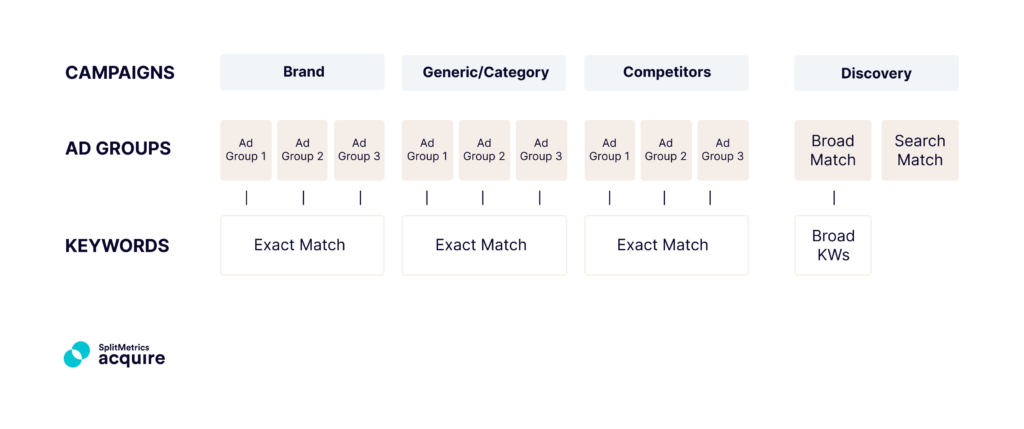
This gateway guide will benefit most those new to Apple Ads advertising platform, either entirely or shifting from Apple Ads Basic to Apple Ads Advanced. We’d recommend it as a must-read for all, considering our free SplitMetrics Acquire Starter Plan account.
Read this article for:
– A step-by-step guide to creating the semantics-based structure for any app
– A peek into advanced structuring methods related to budgeting & scaling
– Tips on automation in SplitMetrics Acquire, with sample rules to use right away
– Advice on adding and managing seasonal promotions and international scaling
From a practical perspective, an account structure in Apple Ads is created and maintained by configuring and categorizing ads, ad groups, and campaigns using the designated options available in Apple Ads and, by extension, SplitMetrics Acquire.
Structured naming of all components is also highly recommended, as it allows easy manual control or setting up automation rules in our system.
A semantics-based account structure recognizes the different purposes of each campaign type, allowing for easy implementation of their unique settings & optimal bidding in Apple Ads. It’s intuitive to manage and navigate and helps target specific user intent. Sticking to the principles of the account structure of choice has many benefits:
These will be especially felt while scaling your operations, as the number of ad groups and variations in Apple Ads, and related activities will increase considerably.
Campaigns that are the basis of this structure are grounded in semantics and not monetary value, so budget management and waterfalling require a strategic approach and careful planning. The article explains how to make your campaigns more granular to streamline budgeting. However, implementing this method requires understanding all the structure components and depends on individual strategy.
Whether you’re new to Apple Ads entirely or have experience with the fully automated service Apple Ads Basic, building and maintaining a proper account structure requires an understanding of certain aspects of your app, in particular, its:
Campaigns contain multiple ad groups. The daily budget and the target market are specified at the campaign level. Campaigns in the semantics-based account structure are:
Ad groups contain keywords that lead to our app’s product page and ad variations that lead to custom product pages. Maximum bids, audience settings, and keywords are specified here. Your structure will most likely have ad groups sorted by:
Targeting the devices together is better unless they differ in performance, in which case separate bids are necessary. Similarly, when re-downloads are significant to you, consider targeting returning users with separate ad groups, even resorting to custom product pages for better conversion rates. We recommend targeting all genders and ages to not cut out users with personalized ads turned off. According to Apple Ads, in the first quarter of 2022 78% of App Store iOS 15 search volume came from devices with Personalized Ads turned off.
Match types specify how your ads will be shown. Apple Ads discovery campaigns use broad match and the Search Match feature. Brand, competitors and generic campaigns always use the exact match method.
The semantics-based account structure is highly flexible. Depending on your strategy, budget plans for international expansion and seasonal marketing; you may implement multiple, more granular campaigns. However, these shifts don’t change the logic behind this structure, which is firmly grounded in user intent.
Discovery campaigns are established to source new keywords in your Apple Ads account. They consist of two ad groups: one utilizing the Search Match feature and the other broad-match keyword matching.
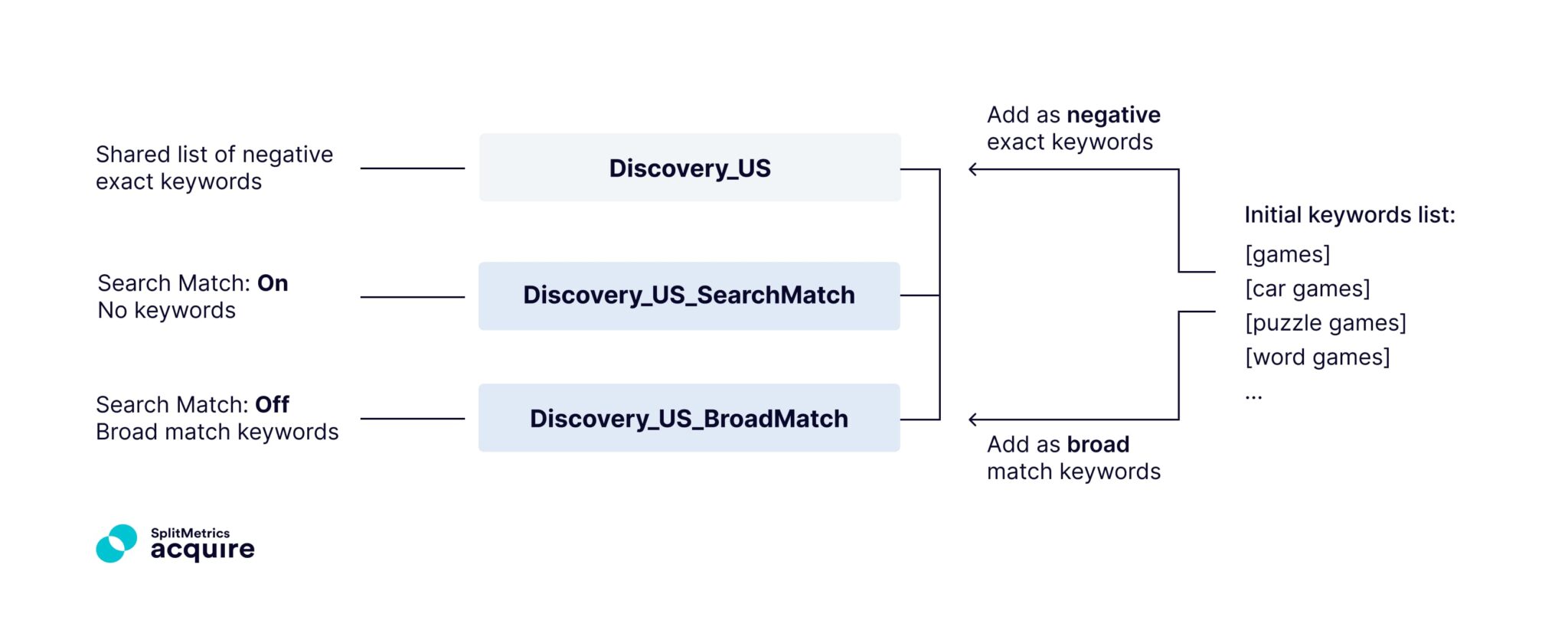

The Search match ad group is essential for two reasons. First, it will provide new keywords that perform well enough to be moved into other campaigns. Second, it automatically matches ads to a wide variety of precise and low search volume (LSV) search queries that can be a source of additional downloads without adding them to exact match groups.
The broad match ad group will be a crucial source of new exact-match keywords but requires an established keyword pool and data to expand upon. For example, add a list of well-performing exact-match keywords to it. This way, it will discover search terms relevant to your top-performing keywords.
Keyword expansion is a critical component of broad-match discovery campaigns. SplitMetrics Acquire provides many tools for keyword research and analysis. Use our Keyword Discovery tool to find and test new keywords. Read more about this process in our article: Apple Ads Keywords in 2024: Basics, Expansion & Best Practices.
Keywords fill flow continuously between your campaigns in the semantics-based account structure. It’s crucial to remember this:
Your discovery campaign should contain all keywords from your brand, generic, and competitor campaigns as exact match negatives!
We highly recommend targeting “All” segments within discovery campaigns (gender, devices, new users, existing users). Remember that their key purpose is to find as many effective keywords as possible. Targeting a specific age range and gender can hinder you from discovering good keyword ideas. You need a wider reach and a more extensive volume instead. This is the optimal solution, given the high percentage of iOS users who have turned off Personalized Ads.
Brand campaigns contain keywords directly associated with your brand, such as the name of your app or publisher. They typically have a straightforward structure consisting of a single exact-match ad group.
There are two reasons for running Apple Ads branded campaigns: user acquisition and brand protection.
User acquisition: brand-related keywords signal high intent, which is reflected in their high conversion rates and usually a significant contribution to downloads despite smaller volumes. To capitalize on this potential, branded keywords are added as exact matches to ad groups and assigned the highest bids. High relevance and intent result in branded campaigns enjoying comparatively lower CPA, CPT, and CPG than generic campaigns. Relying on the organic traffic alone will leave the full potential of these keywords unutilized. Additionally, Apple Ads campaigns are very likely to provide a robust signal for organic rankings.
Brand protection: If you don’t run campaigns for your branded keywords, chances are that your competitors do. The stakes are high: you can lose the most high-quality users who search by your branded queries.
A very significant percentage of all App Store searches include the app title or a publisher name. This means that branded Apple Ads keywords can bring about the biggest influx of traffic.
Boost awareness of your brand by utilizing a multi-placement strategy. Additional Apple Ads placements on the Today and Search tab and product pages may positively influence the performance of your branded campaigns on the App Store. Additional placements will be placed in their dedicated campaigns.
Competitors campaign contains ad groups that target branded keywords related to your competitors. There are some caveats to running them:
Pay special attention to the relevance of these keywords. When evaluating which competitors to target, prioritize relevance over impressions. Pay close attention to the defense level of each keyword to avoid excessive spending.
Regardless, competitors’ branded keywords may still have lower average TTR and higher average CPT than those from other campaigns, but they will still be an essential source of downloads. This largely depends on the app category. In some, branded search terms may be more prevalent than generic ones.
Consider product page ads to divert traffic from your competitors’ product pages. Read more about them in this article: A Digest of SplitMetrics Benchmarks for Product Page Ads Report.
These campaigns are valid because they reach users looking for a specific app but are open to alternatives and offer better solutions to their problems.
To explain the ad group structure of this campaign, let’s take an example of an e-signature app that is relevant for users looking for three types of apps: e-signature (direct competitors), document scanning, and invoicing.
| Ad Group | eSignature | Document scanner | Invoicing |
| Intent level | High | Medium | Low |
| Intent | Users looking for a particular e-signature app is your target audience.Users looking for a particular e-signature app is your target audience. | Users in search of a document scanner app may also be interested in e-signature apps. | There is a chance that people in search of invoicing apps might be interested in an e-signature functionality. |
| Exact keywords | docusigndocusign upload sign docspandadocsignnow | scanner apppdf scannerdocument scannerscan appscan documents | invoice 2goinvoice simpletiny invoicefreshbooks |
Consequently, here’s what the structure of this particular campaign may look like:
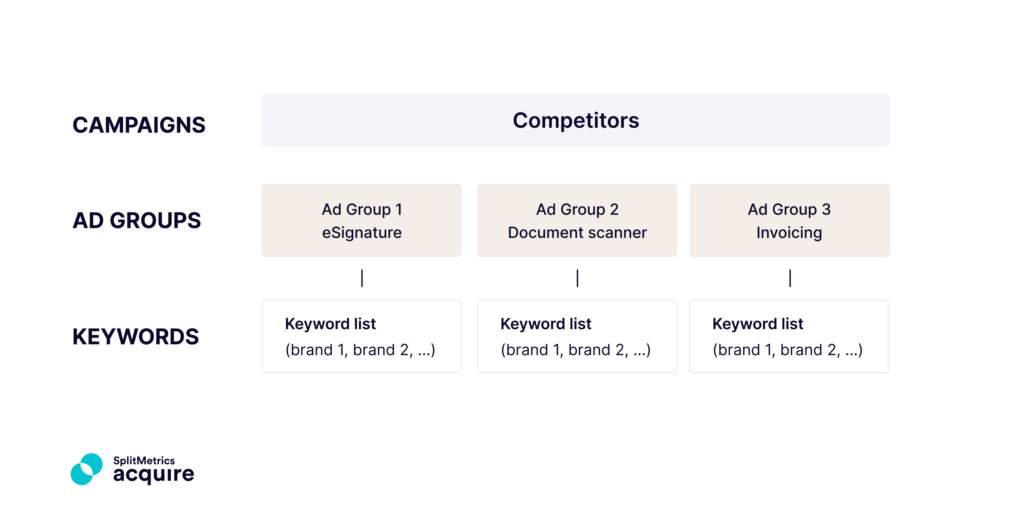
Generic campaigns include keywords related to functionality with varying degrees of relevance. They can help you reach a high-quality audience searching for a solution to their problem. To adequately explain the logic behind this campaign, we’ll use the e-signature app example again.
It has a single core functionality but appeals to users searching for solutions to multiple problems. The results can be sorted by the intent level behind each search term group.
Back to our example e-signature app, in the table below, you can see three ad groups and related user intent:
| Ad Group | eSignature | Document scanner | Invoicing |
| Intent level | High | Medium | Low |
| Intent | Users look for a solution to e-sign their documents. eSignature is the app’s USP and a primary paid feature. | The primary thing that users look for is a document scanning feature. They aren’t necessarily interested in eSignature, but e-signing is the next logical step after creating the digital copy of a paper document. | The target audience may include people who look for an invoicing app. Such a functionality is usually part of document management software. However, searches of this kind are less relevant to the app’s USPs. |
| Exact keywords | electronic signaturesignature appsign documentsdocument signere-signsign | scanner apppdf scannerdocument scannerscan appscan documents | invoiceinvoice makerinvoice appinvoice maker freeinvoice generator |
Once you’ve analyzed the grades of intent and keywords, it’s time to build the sub-structure of your generic campaign. It may look like this:
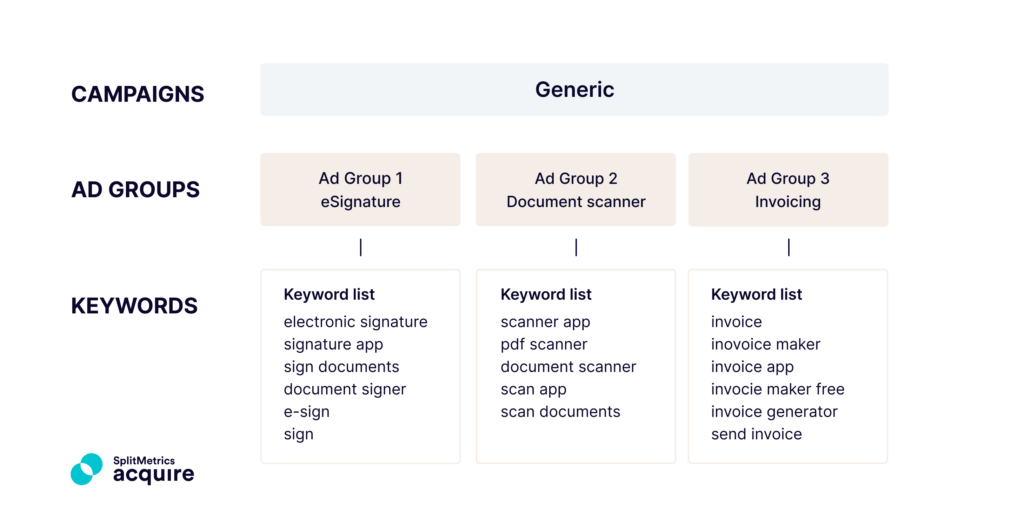
Notice how easy it is to add ad variations into this structure, leading to custom product pages highlighting the different features of your app. Suppose that the e-signature app from our example introduces a scanner functionality. All it takes is to add ad variations for relevant keywords into the Document scanner ad group. All can be accomplished through SplitMetrics Acquire, with a clear custom product page preview.
This structure can be easily copied to target new and returning users separately and consider any other segmentation criteria that might be crucial for your app.
We recommend setting up proxy campaigns (sometimes called testing or probing) to analyze the post-install performance of search terms generated by discovery campaigns. However, we do so only in certain instances, as they require additional maintenance (or automation rules) and budget. They’re implemented optionally after scaling. An alternative solution is to move the search terms as exact matches into a specific campaign and pause it should it not deliver any goals. Please note that proxy campaigns only make sense if an MMP (mobile measurement partner) integration is present.
Set competitive bids and let the campaign run until enough data is accumulated (at least four weeks). Next, keywords with good enough post-install performance should be transferred to exact match campaigns—brand, generic, or competitors. Automating this process or setting up notifications while monitoring keyword performance is recommended to avoid excess spending.
In a semantics-based keyword structure, keywords flow continuously between campaigns. The scheme below explains this motion:
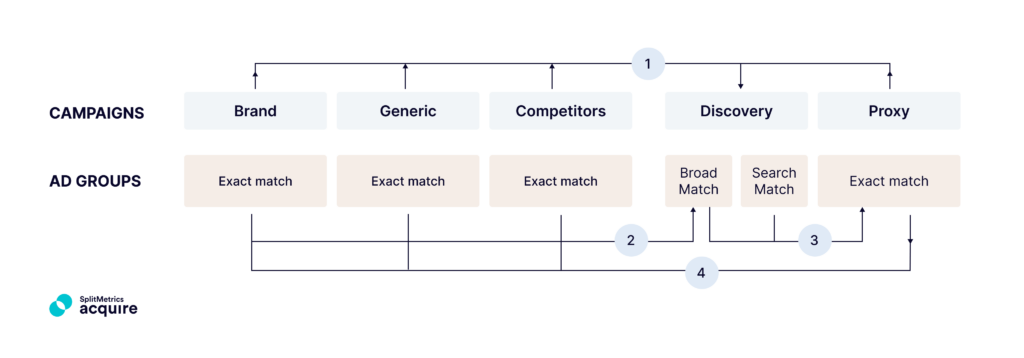
The process is as follows:
It’s recommended that this process be run weekly or bi-weekly. To account for delayed conversions, give yourself at least four weeks before pausing any keywords.
SplitMetrics Acquire can automate all tasks related to maintaining the semantics-based account structure. This includes the keyword flow, budget and bid optimization, and pausing and unpausing keywords. Our system offers many templates of automation rules for easy set-up. Here are some examples of rules that will significantly reduce the workload of any user acquisition manager.
SplitMetrics Acquire offers easy-to-use automation rule templates to manage all the blocks in a semantics-based account structure. They’re described in our Ultimate Automation Guide for SplitMetrics Acquire for 2024.
Here, we’d like to highlight two rules related to the above keyword flow. You can automatically move a keyword from the discovery campaign to a proper ad group in a specific campaign. It means that the system can detect your branded keywords or those belonging to your competitors, as well as generic ones by itself, and move them to a specific ad group in a proper campaign.
Rule 1: move good search terms to an exact match to a proper ad group
Apply to: Search terms
Action: Add as a keyword to [ad group] / Also Negate [in the current campaign]
Condition 1: Downloads greater than 0, CPA less than Target CPA
Condition 2: Insights -> Search Term Type is [my own brand / other brands / generic]
Date range: Previous 14 days
Run frequency: Weekly
Additionally, you can automatically add the best exact-match performers as broad-match keywords to your discovery campaign:
Rule 2: add good exact-match performers as broad match to discovery
Apply to: Keywords
Action: Add as a broad match keyword to [your broad-match ad group]
Condition: Target actions > 0, CPA < Target CPA or ROAS > Target ROAS
Date range: Previous 14 days
Run frequency: Weekly
The semantics-based account structure gives users much flexibility, allowing more advanced budget management, like waterfalling.
Waterfalling is an approach to budget allocation that prioritizes the best-performing branded keywords and assigns the remaining budget to generic and competitor ones based on performance. This requires a more granular campaign approach, as the budget is set on a campaign level.
To streamline budget management and waterfalling, you may establish multiple generic and competitor campaigns, each covering a theme-based ad group.
Let’s examine how the structure would look for our e-signature app:
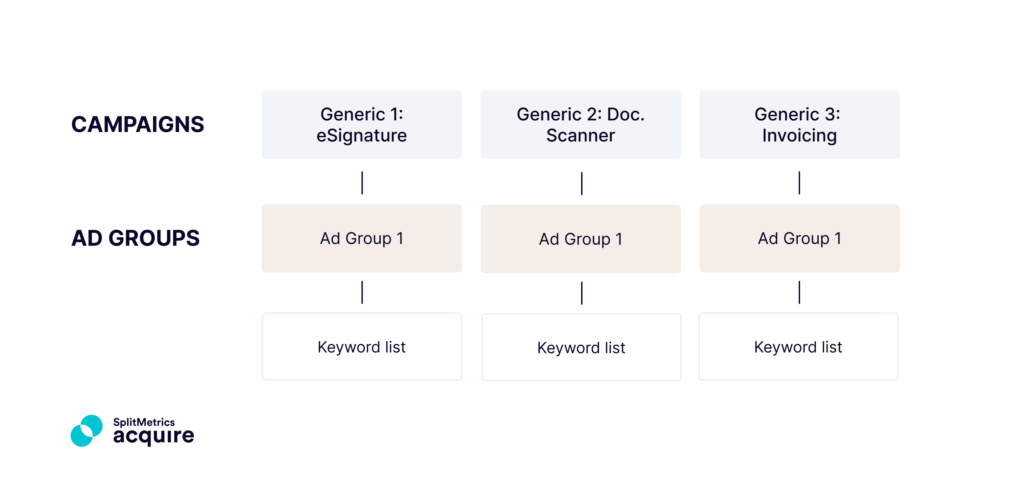
Each theme-based ad group (eSignature, Scanner, and Invoicing) is a separate campaign. This will allow you to be more flexible in budget management and prioritize allocation based on theme performance and user search intent. Apps promoting multiple features can also utilize this type of structuring.
Your approach to the international scaling of your campaigns will depend primarily on the importance of the target market for you and, consequently, your budget structure.
High-priority markets can have a separate budget, and the entire granular campaign structure can be replicated, for example, BRAND_CN, COMPETITORS_CN, GENERIC_CN, and DISCOVERY_CN – for China, with analogical ad groups as in our primary market. SplitMetrics Acquire’s automation rules allow a small team to scale Apple Ads effectively.
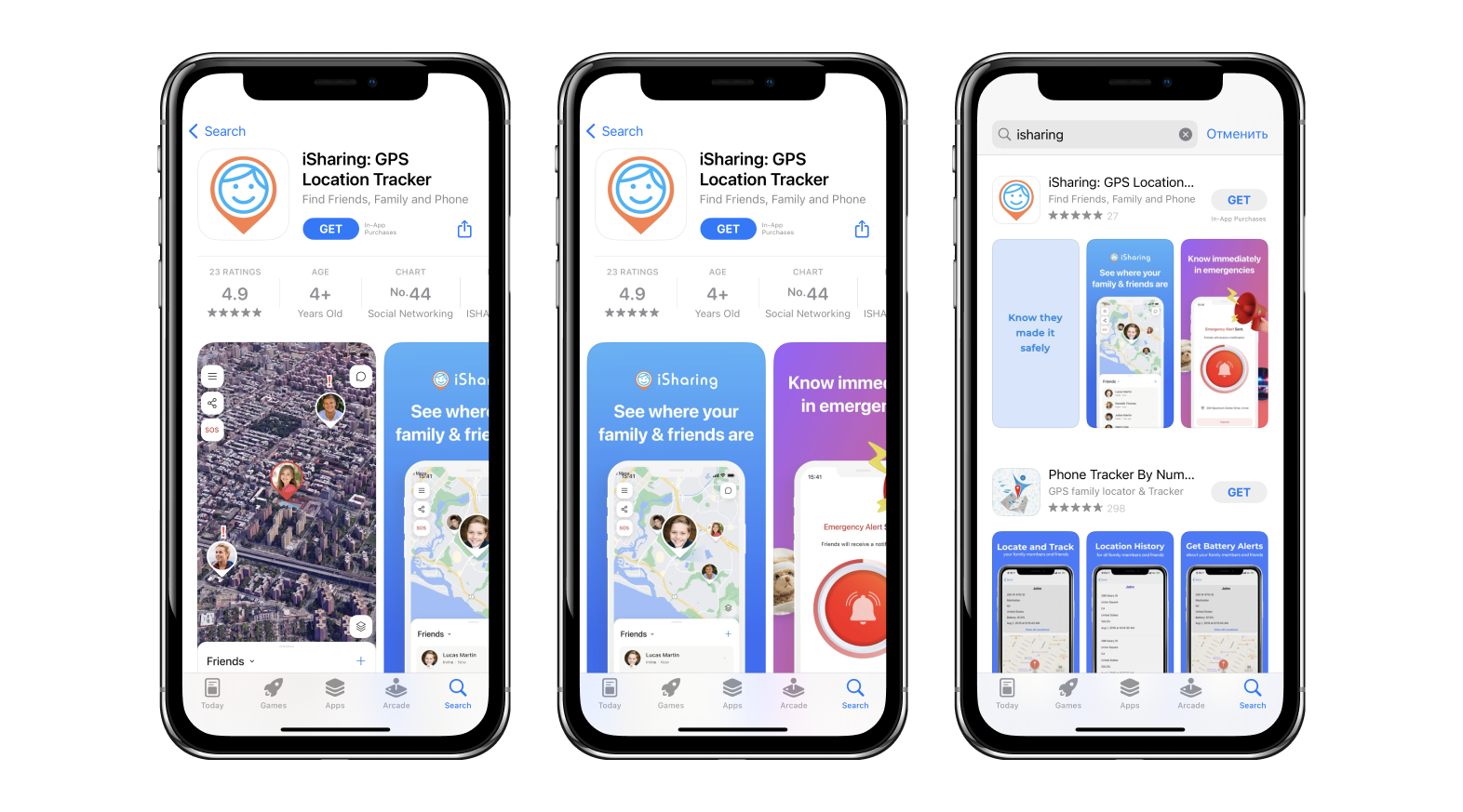
Key markets can also be contained within a single campaign, with multiple ad groups covering discovery, brand, competitors, and generic campaigns. Others can be grouped in a single campaign when they share similar attributes, like value or language.
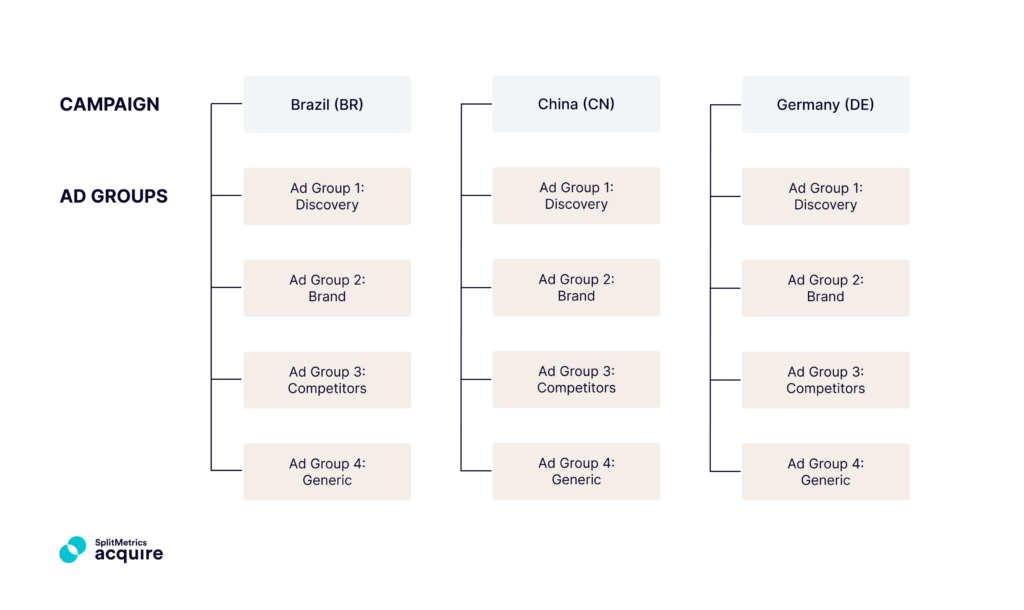
Ultimately, the flexibility of the structure allows multiple approaches.
The logic behind including seasonal and holiday promotions in your structure is similar to international expansion. Certain holidays, like Christmas or Halloween, may be significant enough for your user acquisition efforts to warrant separate budgets.
Refer to our How Can Sports Apps Score During Euro 2024 guide to understand how seasonality affects keywords.
If you have them, creating separate campaigns for them makes sense. Automation rules can be set up to pause campaigns after goals drop to a certain threshold, and they can be easily expanded and reactivated next time.
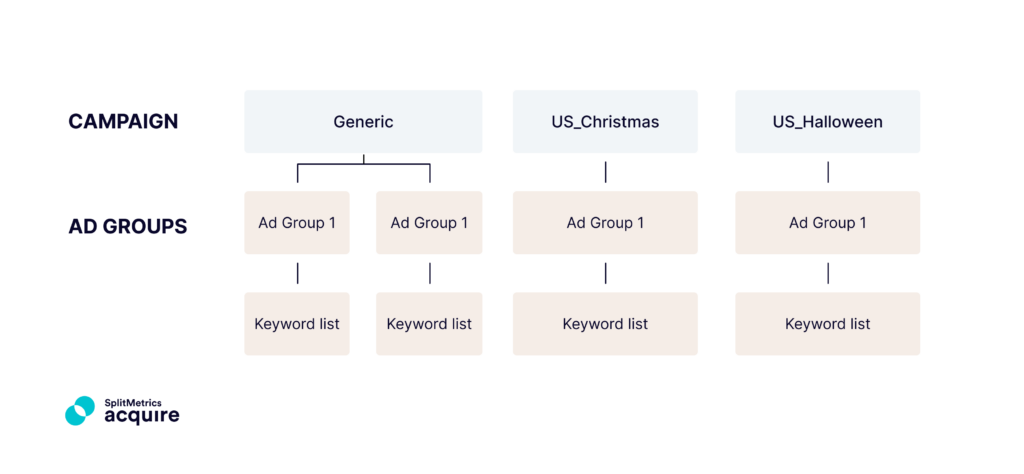
Suppose your generic/category campaign does not have a specified daily budget. In that case, you can add seasonal ad groups with keywords that gain traction during holidays or a specific time of the year (like summer workouts, summer holidays, black friday deals, and so on).
The semantics-based Apple Ads account structure is efficient and time-tested. Its campaigns can be easily replicated in many markets for easy scaling and built-in flexibility, which allows for smooth budget management and waterfalling.
Start planning your account structure today and dive into the free SplitMetrics Starter Plan to start building it immediately! Explore automation rules and our interface, which will help you easily create and navigate your semantics-based account structure!

